Top 5 AI Tools For Analysing MRI and CT Scans in 2025
Published: 2 May 2025
AI is changing the way doctors use MRI and CT scans to diagnose patients. These scans are important tools that help doctors see inside the body without surgery. But reading these images can be tricky and time-consuming. That’s where AI comes in.
In 2025, many new AI tools are helping doctors analyze these scans faster and more accurately. AI can spot small details in images that might be missed by the human eye. This makes it easier for doctors to make quick, informed decisions about patient care.
Have you ever wondered how AI can help make medical scans more accurate? Let’s explore the top 5 AI tools that are shaping the future of MRI and CT scan analysis in healthcare.

How AI Tools Improve MRI and CT Scan Analysis
AI tools are making MRI and CT scan analysis faster, less expensive, more accurate and reliable. Here’s how:
Speed and Accuracy
AI helps process scans much quicker than traditional methods. It can review large sets of images in a fraction of the time it would take a human. This speed is especially helpful in emergency situations where every second counts.
For example, AI can instantly detect potential issues like tumors or fractures in the images, helping doctors to make faster decisions. It’s like having an extra set of eyes that never get slept or tired.
Reducing Human Error
Even the best doctors can miss small details in a scan. AI can help to reduce these mistakes. It highlights areas of concern and makes it easier for doctors to spot problems early. This can lead to better outcomes for patients, as conditions are caught sooner.
Think of it like a GPS that guides you to your destination without missing a turn.
Helping Doctors Make Better Decisions
AI tools don’t replace doctors— rather they help them. By analyzing scans with high precision, AI gives doctors more accurate information to work with. This helps doctors feel more confident when making a diagnosis or planning a treatment.
Also Read: How to Boost your Career in Healthcare
Top 5 AI Tools for MRI and CT Scan 2025
Following are the most famous AI tools used for in-depth analysis of MRI and CT scans all around the globe.
1). MindGlide
MindGlide is an AI tool developed by researchers at University College London (UCL) to assist in analyzing brain MRI scans, particularly for detecting subtle changes associated with multiple sclerosis. Traditionally, interpreting these changes required expert radiologists and could take a significant amount of time. MindGlide aims to streamline this process by making it faster and more accessible.
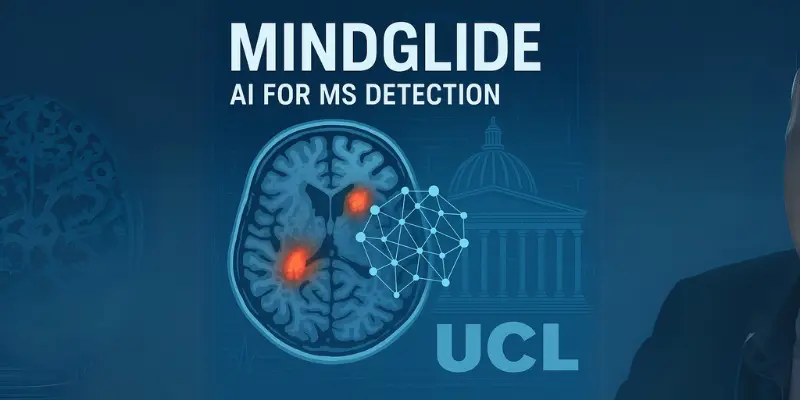
Key AI Features
- Rapid Analysis: MindGlide can process brain MRI scans in just 5–10 seconds per image, significantly reducing the time required for analysis.
- High Accuracy: In tests with over 14,000 images, MindGlide outperformed existing tools in detecting MS lesions, demonstrating its reliability across different brain regions and scan types.
- Clinical Potential: The tool can interpret routine scans that were previously unusable for MS analysis, unlocking insights from millions of archived hospital scans and transforming MS care.
Also Read: Top 10 AI Caregiver Tools in Healthcare 2025
Pros and Cons
Pros:
- Speed: Provides quick analysis, allowing for timely decision-making in clinical settings.
- Accuracy: Demonstrates high sensitivity in detecting MS related changes, potentially leading to better patient outcomes.
- Accessibility: Enables the use of routine scans for MS monitoring, broadening the scope of available data for clinicians.
Cons:
- Specific Use Case: Currently tailored for MS detection, limiting its application to other conditions.
- Dependence on Quality of Input Data: The effectiveness of the tool may be influenced by the quality and consistency of the MRI scans inputted.
MindGlide represents a significant advancement in the integration of AI into medical imaging, offering a promising solution for enhancing the efficiency and accuracy of MS diagnosis and monitoring.
Also Read: AI Stethoscope in Healthcare
2). Aidoc
Aidoc is an AI-powered medical imaging platform designed to assist radiologists in analyzing CT scans quickly and accurately. It focuses on detecting critical conditions such as brain hemorrhages, pulmonary embolisms and cervical spine fractures. By integrating seamlessly into existing radiology workflows, Aidoc aims to enhance diagnostic efficiency and reduce the time to treatment for patients.
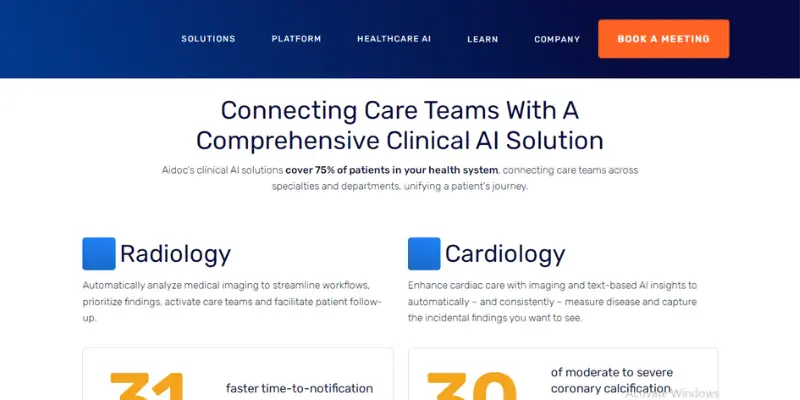
Key AI Features
- Real-Time Analysis: Aidoc processes CT scans in real-time, providing immediate alerts to radiologists about potential critical findings.
- Comprehensive Detection: The platform is capable of identifying a wide range of conditions, including intracranial hemorrhages, pulmonary embolisms and cervical spine fractures.
- Prioritization of Critical Cases: Aidoc uses AI to prioritize urgent cases, ensuring that radiologists address the most critical findings first.
- Integration with PACS: The system integrates with existing Picture Archiving and Communication Systems (PACS), allowing for seamless incorporation into current radiology workflows.
Pros and Cons
Pros:
- Enhanced Efficiency: By automating the initial analysis of CT scans, Aidoc allows radiologists to focus on more complex cases which improves overall workflow efficiency.
- Improved Patient Outcomes: The real-time alerts enable faster diagnosis and treatment of critical conditions, potentially improving patient outcomes.
- Scalability: Aidoc’s integration with existing systems makes it scalable across various healthcare settings from small clinics to large hospitals.
Cons:
- Dependence on Data Quality: The accuracy of Aidoc’s AI models is contingent on the quality of the input data; poor-quality scans may affect performance.
- Limited Scope: While Aidoc excels in detecting certain conditions, it may not be as effective for other pathologies, necessitating complementary tools for comprehensive analysis.
Aidoc represents a significant advancement in the integration of AI into medical imaging, offering a promising solution for enhancing the efficiency and accuracy of CT scan analysis in healthcare.
3). Zebra Medical Vision
Zebra Medical Vision is an AI-powered platform that assists doctors in analyzing medical images like X-rays, CT scans and MRIs. It helps identify various health issues including lung diseases, liver problems and bone conditions. By providing quick and accurate insights, Zebra Medical Vision supports doctors in making better decisions for patient care.
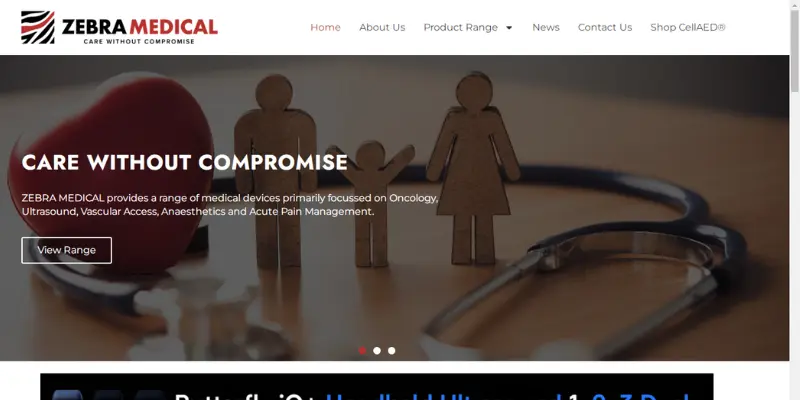
Key AI Features
- Wide Range of Detection: Zebra Medical Vision can detect multiple conditions such as breast cancer, lung diseases and liver abnormalities by analyzing different types of medical images.
- Fast Analysis: The tool processes images quickly and allows doctors to receive results promptly and start treatment sooner.
- Integration with Existing Systems: It works seamlessly with the hospital’s current systems, making it easier for medical staff to adopt and use without significant changes to their workflow.
Pros and Cons
Pros:
- Improved Accuracy: By assisting in detecting various conditions, it helps to reduce the chances of missed diagnoses.
- Time-Saving: Quick analysis means patients can receive care faster, which is crucial in serious health situations.
- Supports Doctors: Acts as an additional tool for doctors, providing a second opinion and enhancing confidence in diagnosis.
Cons:
- Dependence on Image Quality: The accuracy of the AI analysis relies on the quality of the medical images provided. So, bad images may lead to bad decisions.
- Limited to Certain Conditions: While it covers many health issues, it may not detect all possible conditions, so doctors still need to use their judgment.
Zebra Medical Vision is a valuable tool in modern healthcare, offering support to doctors by providing quick and accurate analysis of medical images, ultimately aiming to improve patient outcomes.
4). Avicenna.AI
Avicenna.AI is an advanced AI-powered tool designed to assist doctors in analyzing CT scans, especially in emergency situations. It helps to identify critical conditions like strokes, brain bleeds and lung clots quickly and accurately. By automating the detection process, Avicenna.AI allows doctors to focus on treating patients faster.
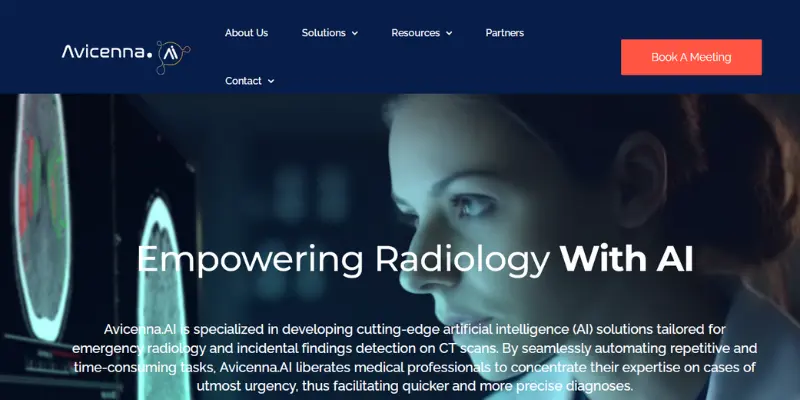
Key AI Features
- Rapid Detection: Avicenna.AI analyzes CT scans in real-time, identifying urgent issues such as intracranial hemorrhages and pulmonary embolisms within seconds.
- Seamless Integration: The tool integrates smoothly with existing hospital systems, automatically sending alerts and annotated images to doctors without disrupting their workflow.
- Automated Alerts: When a critical condition is detected, Avicenna.AI sends immediate notifications to the medical team and ensures prompt attention.
Pros and Cons
Pros:
- Speed: Provides quick analysis, allowing for timely decision-making in emergency settings.
- Accuracy: Demonstrates high sensitivity in detecting life-threatening conditions, potentially leading to better patient outcomes.
- Efficiency: Reduces the workload on radiologists by automating the initial scan review process.
Cons:
- Specific Use Case: Currently tailored for emergency radiology, limiting its application to other areas.
- Dependence on Image Quality: The effectiveness of the tool may be influenced by the quality and consistency of the CT scans inputted.
Avicenna.AI represents a significant advancement in the integration of AI into medical imaging, offering a promising solution for enhancing the efficiency and accuracy of CT scan analysis in emergency healthcare settings.
5). Viz.ai
Viz.ai is an AI platform that helps doctors to analyze medical images like CT scans and MRIs quickly. It focuses on detecting serious conditions such as strokes, heart problems and blood clots. By quickly identifying these issues, Viz.ai enables doctors to make faster decisions and provide timely treatment.
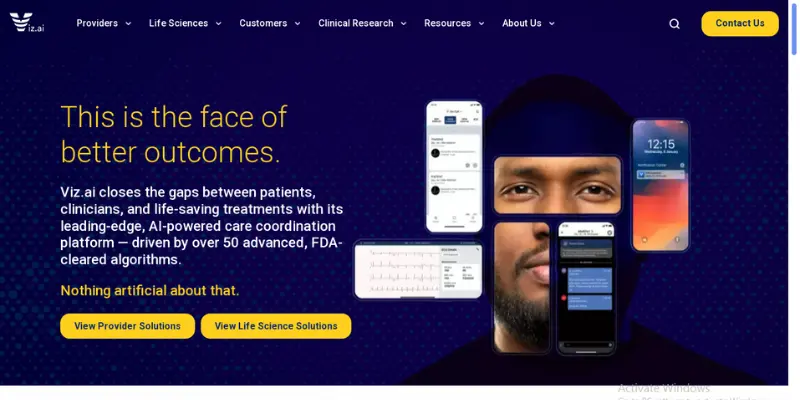
Key AI Features
- Real-Time Alerts: Viz.ai scans images and sends immediate notifications to doctors if it detects something unusual.
- 3D Imaging: The platform can create detailed 3D images from CT scans which helps doctors to see the problem more clearly.
- Mobile Access: Doctors can view images and patient information on their phones, allowing them to respond quickly, even when they are not in the hospital.
- Team Communication: Viz.ai allows medical teams to chat and share information securely, ensuring everyone is on the same page.
Pros and Cons
Pros:
- Speed: Helps doctors identify serious conditions quickly, which can save lives.
- Clarity: Provides clear images and information, making it easier to understand what’s happening inside the body.
- Convenience: Accessible on mobile devices, so doctors can act fast, no matter where they are.
Cons:
- Specific Focus: Currently, Viz.ai is mainly used for certain conditions like strokes and heart issues, so it might not detect other problems.
- Dependence on Technology: Relies on good internet connections and compatible devices to function properly.
Viz.ai is a valuable tool in modern healthcare, offering quick and accurate analysis of medical images to support doctors in making timely decisions for patient care.
How to Choose the Right AI Tool for MRI and CT Scan Analysis
Choosing the right AI tool can feel confusing. But don’t worry, it’s easier when you know what to look for. Let’s go through the most important things to keep in mind.
Factors to Consider
Here are the top things to check before picking an AI tool:
1. Accuracy
- Choose a tool that shows high accuracy in detecting medical issues.
- Look for tools that have been tested in real hospitals or approved by health authorities like the FDA.
2. Ease of Use
- Pick a tool that’s simple to use, even for new users.
- It should have a clean dashboard and easy to read results.
3. Speed
- The tool should give quick results, especially in emergencies.
- Faster tools help doctors act sooner and save more lives.
4. Compatibility
- Make sure the tool works well with your existing systems like PACS, EMR or hospital scanners.
- This avoids technical problems during setup.
5. Clinical Support
- A good AI tool should be backed by real doctors and healthcare experts.
- Check if it’s being used by top hospitals or clinics.
6. Data Privacy and Security
- The tool must protect patient data.
- It should follow privacy laws like HIPAA in the U.S. or GDPR in Europe.
7. Cost and Licensing
- Make sure it fits your budget.
- Some tools offer flexible plans or trials great for small clinics.
Tips for Implementation
Ready to get started with AI tools? Here are some simple steps to follow:
✅ Start with a Pilot
Test the AI tool in one department first. See how it works before rolling it out across the other departments or whole hospital.
✅ Train Your Staff
Give short training sessions to your team. Show them how the AI works and how it helps not replace their work.
✅ Set Clear Goals
Decide what you want from the tool. Do you want faster diagnoses? Better accuracy? Clear goals make it easier to measure success.
✅ Monitor the Results
Check the AI tool’s performance every few months. If it’s working well, you will see fewer errors and faster care.
✅ Keep Communicating
Get feedback from doctors, nurses and IT staff. This helps you make improvements and avoid mistakes.
Quick Example:
Imagine a small hospital in Texas started using an AI tool for stroke detection. They tested it for 3 months in the ER. After training their team and reviewing early results, they expanded it to other departments. Stroke detection time dropped by 40%.
Conclusion
AI tools are changing the way we look at MRI and CT scans. They help doctors spot problems faster and treat patients more effectively. In this article, we have seen 5 powerful AI tools that are making a big impact in 2025. Each one has something unique to offer, some focus on strokes, others on cancer or full-body scans.
Take your time to explore the list. Think about what matters most for your hospital or clinic. Is it speed, accuracy or ease of use? My personal tip is to start with one tool that matches your current workflow. Test it out, get comfortable and build from there.
The right AI tool can make a huge difference not just for doctors but for every patient who needs faster and safer care.
Related Queries
Here are frequently asked questions about AI Tools in Healthcare:
Medical AI tools often use subscription models ranging from $500-$5000 per month depending on facility size and usage volume. Some vendors offer pay per scan pricing that scales with your actual usage. Many providers also offer free trials or pilot programs to test compatibility before full implementation.
Most modern AI medical imaging tools are cloud-based and don’t require specialized hardware at your facility. They typically run on standard computers that can access your existing PACS or imaging system. Some advanced applications may benefit from GPU acceleration for faster processing.
AI tools for medical imaging are considered decision support tools, not replacements for medical professionals. The treating physician maintains legal responsibility for final diagnostic decisions. Most regulatory frameworks require AI to be used as an assistant rather than an autonomous diagnostic system.
Medical imaging AI is trained on thousands of annotated scans reviewed by expert radiologists. The algorithms learn to recognize patterns associated with specific conditions or abnormalities. Before release, they undergo rigorous validation against independent test datasets and often clinical trials.
Most clinical AI tools require regulatory approval like FDA clearance in the US or CE marking in Europe. The approval process typically involves demonstrating safety, effectiveness and validation data. Different tools may have different levels of approval for specific conditions or use cases.
Medical imaging AI tools must comply with healthcare privacy laws like HIPAA or GDPR. Most of these tools use encryption, secure data transmission and strict access controls to protect patient information. Many tools also offer anonymization features that remove identifying information from images before processing.
Most AI imaging tools are designed to integrate with standard hospital systems like PACS, RIS and EMRs. Integration typically requires some IT configuration but uses standard healthcare protocols like DICOM and HL7. Your IT team or the vendor will handle most of the technical setup.
Most AI imaging tools are designed with intuitive interfaces requiring minimal training, typically just a few hours. The learning curve focuses on understanding how to interpret AI findings rather than operating complex software. Many vendors provide initial training sessions and ongoing support for users.
According to reports medical imaging AI tools typically achieve 85-95% accuracy in their specialized domains, comparable to experienced radiologists. Some tools even outperform humans in specific narrow tasks like detecting certain fractures or nodules. The best results come from AI and radiologists working together rather than either working alone.
Most medical imaging AI platforms receive regular updates every 3-6 months with improved algorithms and features. These updates incorporate new research, expanded training data and feedback from clinical use. Updates typically happen automatically for cloud-based systems with minimal disruption to workflow.





